 Stefania
Stefania
 Stefania
Stefania
“Queen of Icelandic Sheep”
by Susan Briggs copyright 2008
This article is based on a taped interview with Stefania during a visit to Yeoman Farm in 1995. Stefania died of complications from cancer in 2007. This is her story of bringing the Icelandic Sheep breed to North America. Photo by Susan Briggs
I rang the doorbell of the old two story white farm house in the rural village of Parham Ontario not knowing what to expect. The 5 foot “something” woman that opened the door was surprising. The first thing I noticed about Stefania was her gold front tooth that flashed at me as she smiled. The second thing I noticed were her eyes that were sparkling, lively and full of self confidence. Her posture was very erect like a ballet dancer carries herself, and she cocked and wagged her head when she talked in such a way that exuded self confidence with a twist of mischief. That first impression suggested that she would look at home in a swash-buckling pirate’s costume. She was intriguing, well educated and engaging to say the least. From there on the visit was a whirlwind of seeing the largest flock of Icelandic sheep in North America, and I was overwhelmed. I took as many photos as I could so that I could study them later. I spent a lot of time just wandering around looking and observing the animals with Stefania telling the stories about each ewe or ram.
I was there to get some additions to the animals that I had bought from Stefania the previous year. I was hungry for information on this breed, and Stefania was the only source. I asked her to tell me the story of how she imported the sheep. She was cooking dinner for us and started talking as I clicked on the tape recorder. From the two tapes she filled with stories and laughter, the events of her life unfolded.
Born and raised in Reykjavik Iceland, Stefania Thordis Sveinbjarnardottir had no idea what a profound effect her 1968 visit to Canada (to be with her pregnant sister) would have on her future. She also never dreamed that her mission in life would be to introduce the Icelandic sheep breed to North America. During that first visit to Canada in1968, she fell in love with the Canadian landscape and friendly people. After a year in Cypress, she went back to Iceland but kept thinking about Canada. In 1971, she returned for a three week bus trip, accompanied by her first daughter, which took her from New York through Quebec. This trip was the deciding factor, and in1973 she immigrated to Kingston, Quebec and got a job in accounting.
Shortly after she arrived, she met Ray Dignum, an electrical engineer and professor at The Royal Military College of Canada, and they were married sometime after. When Ray’s parents died and left him a small inheritance, they decided to try and find a country home and live the “Harrowsmith” dream of a back-to-the-land lifestyle. ( Harrowsmith was a magazine similar to The Mother Earth News.) The thinking at the time was: “If there was war you could live in your basement and eat your cows”, Stef quipped.
An extensive search turned up a rundown farm with an old house in sad shape and a big old timber framed barn. The realtor coyly whisked them rapidly through the house (that needed a lot of repair), and out onto the mature sugar bush. The sugar maples were at peak fall color with brilliant scarlet leaves against dark tree trunks and looked like a magnificent cathedral. Stef and Ray were sold on the spectacular beauty of the place and didn’t notice the numerous rock outcroppings and massive boulders rising out of the land in profusion which relegated much of this land to poor quality grazing at best. They were mainly concerned about the one hour commute to Kingston each day. After they found a co-worker that had been making the commute daily for 13 years, they decided that if he could do it, then they could too.
Stef and Ray moved to the farm on the outskirts of the village of Parham in the spring of 1979. They named it Yeoman Farm after the name of the playing field at Ray’s old school in Tonbridge, Kent, England. Their friends in Kingston gave them only two to three years before they would become disenchanted and return to the city. Both Ray and Stefania were indeed city kids; Ray having been raised in the outskirts of London and Stefania in the Iceland capital city of Reykjavik. It was a crazy dream, but they both continued working in Kingston for three years until the demands of the growing farm got too great. It was logical for Stefania to be the first one to quit her job as she was expecting the birth of her second daughter, Louise, and because Ray had better pension opportunities.
At first they had rabbits, then 15 sheep and 3 cows, some horses and pigs. A jersey cow hand milked by Stefania provided all of their butter and milk. Stef even tried her hand at cheese making. The basement soon filled up with wheels of cheese that were turned everyday for 6 months. The first taste of their home made cheese stopped all further cheese making as it had a sour rotten flavor. Other homestead projects were also disappointing. The jersey had twin heifers but when bred back via AI, the cow developed toxoplasmosis from infected semen, aborted and was sent to auction.
From the start, Stefania didn’t realize that the sheep in the rest of the world did not look like her beloved Icelandic sheep for which she was getting homesick. You see, she explained, as a child she and other Icelandic children were sent out to the countryside for the whole summer to live on the sheep and dairy farms of friends and relatives. This was partly to help out with the farm work and partly to strengthen family ties. These were wonderful carefree days filled with games, cooking and Icelandic sheep. The kids helped out by taking out the stove ashes, raking the hay, bringing the cows home at night to be milked and carrying coffee to the field workers.
The kids all played “farm” in the way that Icelandic children had played it for centuries. Sheep bones and horns were their livestock. The horns were the sheep, the long leg bones were the horses and the small pastern bone was the dog. The jawbones turned upside down were the cows with the molars being the udder. The children built small turf houses just like the traditional houses of the original settlers. To imitate the big fall round up the children would fling the horns (sheep) far and wide and then use the horses (leg bones) and dogs (pastern bones) to gather the sheep. These traditional toys were used from the beginning of time until, sadly, plastic animals became available.
The kids were imitating the annual Fall sheep round up, called a Rettir , which happens each Fall in Iceland when the sheep are gathered up from the thousands of acres of rough wild mountainous open range and returned to their farms for the winter. Each district has its own Rettir in the fall, and these events are community celebrations complete with drinking, singing and sorting the sheep.
Some of Stefania’s fondest memories were of these childhood farm visits. She related a story about one time in particular when she was a young girl, sitting on the unfinished floor of a new farm house that was being built. She was playing with a box of shells and bowls while the lady of the house sang and spun wool. This was one of those rare moments in a person’s life that is so peaceful and perfect and as close to nirvana as most of us get here on earth, according to Stefania. She used this visual image of peace when she faced tough times in her life
Iceland at that time was safe for children to travel unaccompanied. Stefania related one story when she was 8 years old and traveled by herself from the summer farm in the country, taking the plane and bus to reach her home in Reykjavik. She surprised her family who hadn’t expected her. This confidence built up at such early age helped “Disa”, as she was nicknamed by her family, to demonstrate the confidence and self assurance she would need many times later in her life.
So here she was, years later in the Canadian countryside, ready for Icelandic sheep. In all of her searching, she could find only two wild, crazy, fence-busting. expensive Scottish blackface sheep, an old rambouillet ewe, a few Dorsets, Suffolks and Hampshires. But these were not the sheep of Stefania’s childhood. These more modern breeds had a loud guttural "Blah Blah", and sounded off frequently. She remembered her beloved Icelandics as having the soft occasional "Ma Ma" bleatings. These modern breeds were “ugly” in Stefania’s way of thinking, all white and polled, and not the multi colored horned beauties of her childhood.
Since there were no Icelandics to be found in North America, she and Ray settled for some Columbia sheep from 3 different breeders. One breeder in the USA was auctioning off his whole flock. Unbeknownst to Ray and Stefania, this flock was infected with OPP (Ovine Progressive Pneumonia), a virus that wrecks havoc with the health of a flock. The Columbias didn’t thrive. The lambs were weak, the ewes became skinny and started dying. Neither Ray nor Stef suspected the cause was OPP. Stefania knew that Icelandic sheep were much hardier and healthier than the Columbias that they were trying to raise and wrote to Iceland to ask about the breed. The response that came back described an animal that finished at 90 to 100 pounds and gave 4 to 5 pounds of wool. This was disappointing in comparison to the 15 pounds of wool that the Columbias gave along with the 120 pound lambs they produced. Then Stef realized that the Columbias took a year to reach that 120 pound size while the Icelandic lambs reached the 90 to 100 pound size in 4 to 5 months on pasture and mothers milk which made them efficient producers of meat and fleece.
Meanwhile their mixed flock of Columbias, et al, continued to do poorly. Finally in desperation Ray said, “If we are losing money anyway, we might as well lose it on something that we want to have”. He gave Stef permission to try to import some Icelandic sheep from Iceland. In 1984, Stefania flew to Iceland to help celebrate her mothers 80th birthday and told her family of her dream to own and raise some Icelandic sheep on her farm in Canada. Her family advised her that it was against the law to export the sheep: “It is illegal and no one has ever done it”, they said. But Stef thought, why not try for it? What did she have to lose?
She went to the Minister of Agriculture, the Agricultural Society and the Chief Veterinarian of Iceland. They all agreed to issue her a permit to export the sheep if she met all of the conditions of the Chief Veterinarian of Iceland. They also said that several Americans had tried before to export the sheep but that there was no follow through. The vet at that time was Dr Paulsson , a difficult man to deal with and one of the world's leading authorities on Scrapie and OPP. He gave his OK for the export thinking perhaps that this project would go no further. Stef left Iceland with a permit to export 12 sheep. Her plan was to go to Iceland the next fall and pick out the sheep and somehow get them to Canada. Back in Canada she started working on what she needed to import them. Dr Macklehern was helpful and explained that the sheep would have to fly directly to The Mirabel Quebec Quarantine station.
With this problem overcome, Stef headed for Iceland in September with her toddler daughter Louise in tow. In New York their flight was delayed because of engine trouble. This was all that was needed to send Stefania, who was terrified of flying, back to Canada on the next flight, “...like a dog with its tail between its legs”, she said. As it turned out it was just as well; unbeknownst to Stef, there was a general strike going on in Iceland, and it would have been impossible to get the needed lab and paperwork completed.
The next spring she and young Louise tried again, and made it to Reykjavik Iceland where she presented her permit to the woman at the Ministry of Agriculture. This woman told her that permits were only good for one year and that hers was now outdated. Stefania looked at the permit, noted that there was no expiration date on it, and declared the permit was still valid. She then moved quickly and got a list of sheep breeders and farms in the Vestur-Skaftafellssısla area from Dr Dyrmundsson, her mentor and an Icelandic sheep specialist. The above named area is a province on the East side of Iceland that is isolated from the rest of the country by glaciers, rivers and the sea. Canada would only accept sheep from this area of Iceland, because the animals in this area had never been exposed to the diseases that were brought to Iceland with an earlier importation of rams from Finland that was meant to improve the meat characteristics of the breed, but instead introduced new diseases to Iceland
Most Icelandic sheep graze communally on vast portions of open range in the interior of the country during the summer. Disease could readily spread in this communal open range setting. Only those sheep that were isolated from mingling with this national flock were saved from infection. The sheep isolated in the Vestur-Skaftafellssısla district in SE Iceland were free of diseases so it was from these flocks that Stefania could select her 12 sheep.
Now Stefania faced the problem of finding sheep to buy. It was May when the sheep are customarily let out on the vast open range and are not at their home farms. But Stef persisted and she began to accumulate sheep. The minister of Agriculture had a good ram born at his Hunkubakkar farm, a polled white fellow #830, who was built like a pig. A young couple that had taken Stefania seriously the year before had held back some yearlings, and Stef selected a white horned ram, and 5 ewes from Kirkjubaejarklaustur farm. Stefania wanted more colored ewes. She called around to locate 2 greys and one moorit (brown) ewe. One of the grey ewes was scrawny and wild. Then a polled black ewe was found and another moorit ewe. They were each purchased for meat price plus 10% which equated about $300.
Stef had bought rams from brothers that had a friendly rivalry. One raised horned sheep and the other polled Icelandics. Each thought that their genetics were better. When the rams were weighed, the horned ram outweighed the polled one by 10 kilos. The owner of the horned ram quipped, “Go tell my brother that the horns weigh 10 kilos!”
The next job was to gather the sheep and put them in quarantine on one farm for two weeks while the blood work was done. Everyone was helpful as Stef drove through the middle of the night making the arrangements accompanied by tiny Louise, holding her blanket closely. The blood samples were taken by a nearby vet. His wife was furious that Stef intended to take the sheep out of the country which was against the law, and she tried to discourage her husband from taking the samples. However, the blood samples were drawn and taken to Reykjavik. It was the weekend and so the samples were taken to the house of Dr Siversson whose wife was used to having blood samples in her refrigerator. From there the blood was flown to Norway to be tested for B. Ovis, Lepto, Johnes and Chlamydia. Testing took the full two weeks.
When the tests came back negative for disease, the next step was to pick up the final papers from the Chief Veterinarian's office. He was angry (presumably because he had not expected her to follow through with this importation and now was being put in an awkward position) and told her that there was one paper missing that had not arrived from Canada, that she couldn’t leave without it, and he pushed her out of the office with a terse goodbye and closed the door behind her. She was terrified that all of her hard work would go down the drain.
The next morning was Saturday and she had scheduled to meet the pilots to pay them one half of their fee, the second half being guaranteed by her brother-in law in Iceland. At 9:00 she met with the pilots and told them about the unexpected problem. “So we are not going then?” one said. The other urged her to try and call Dr Macklehern in Canada to see if the problem could be fixed. Because it was Saturday all offices in Canada were closed, but she vaguely remembered Dr Macklehern talking about his home in Anprior. She found his name with the help of directory assistance and called. After many rings, he answered. He was just going out the door for the weekend and said, “No,” she didn’t need any further papers and, “Yes”, she could proceed with the importation. He further volunteered to call Goose Bay, Canada and get permission for them to land there to refuel before going onto Mirabel, Quebec. While Stef made the calls, toddler Louise sat under the desk and sucked her thumb.
The two young pilots that Stefania hired agreed to take the seats out of their Cessna to accommodate the 12 sheep crates and to fly the sheep from Iceland to Canada for $14,000. The instructions from the Chief Veterinarian in Iceland were that the pilots would have to take a gun along as a safety precaution and shoot any sheep that caused a problem! Furthermore, the sheep were to be watered at each refueling stop.
The sheep had to be brought to the Keflavik airport in Iceland from their home district for their flight to Canada. Iceland’s Chief Veterinarian assumed that Stef would haul them by truck from the farm, many miles away, to the Keflavik airport, and a permit was needed for this. The vet thought that he had Stef in a "Catch 22", since Iceland’s disease prevention laws did not allow live sheep from a district to be transported through any other district and several districts had to be passed through to get to the airport. Had Stefania had asked for a permit, it would have been denied and the export would not go through. But Stefania knew nothing of this law so never applied for a permit. Instead, she had planned to have the Cessna fly to the sheep’s home district and land on a little known emergency airstrip to load. In this way, the sheep would be able to get to Keflavik without needing a permit, but not breaking any rules either!
At this point nothing could stop the exportation except the weather. Monday came and the airport was socked in. Time was of the essence as the space at the quarantine station in Mirabel Canada, would only be held open for the sheep for three days, Monday through Wednesday. If she missed this window, she would have to wait for another opening to bring the sheep in at another time.
Meanwhile the Icelandic press got wind of the project and asked for an interview and photos. Stefania granted the interview only if the news release was timed for publication only after the sheep's successful departure on the Canada- bound plane. The press agreed.
Monday came, and there could be no departure as the Keflavik airport was socked in by bad weather. Bright and early Tuesday morning at 6 AM, the pilots were at the airport and took advantage of a break in the weather to fly out to the sheep’s home district to pick them up. The plane then flew back to refuel at Keflavik as fast as possible and soon after departed for Greenland. The timing was a miracle as this was the only window for flying for the next week. The next stop after Greenland was Goose Bay Canada to refuel and then on to Mirabel, Quebec.
While the pilots and sheep were making their way to Canada, Stefania flew home via a commercial airline, drove to Mirabel with $7000 in cash in her pocket to meet the pilots at 11PM. They needed to be paid cash as they had spent all they had in Greenland. When she shelled out the cash from her big wad, they exclaimed, “Are you crazy carrying all that cash?” "Crazy" might not begin to describe what Stef had just accomplished!
At Mirabel, the sheep were unloaded into an open trailer with a man hanging on the side for the ride to the Quarantine station. His purpose was to beat the sheep on the head when the frightened animals tried to leap out! When the sheep were safely penned, Dr Durocher showed Stefania around the facility. In the quarantine pens were animals of all kinds. But one was very unusual. It was a pot bellied pig from Vietnam. This was the first brought into North America and started the pot bellied pig craze. The sheep stayed at Mirabel for 30 days during which they were retested and then released. The costs included: $2000 for the quarantine, $15,000 for the plane and blood tests, and $4944 for the sheep. Including Stefania’s travel expenses, the total cost was $25,000 for 12 sheep or $2083 each.
Back in Iceland, as soon as the sheep left the airport for Canada, the press released a news bulletin about the export followed by a newspaper article the next day. Angry protest letters to the editor followed noting that the export was illegal and that Iceland was losing its special animals. Some letters accused Stefania of being a crazy foreigner; other letters were negative against Icelanders that didn’t want to live in Iceland but were taking the animals out.
“But it was too late to close the barn door when the horse was already gone”, quipped Stefania. Later, when things quieted down, the Iceland parliament passed a law allowing her export after the fact. Stefania had pulled off a caper that would make a pirate proud.
When Stefania got the sheep home, she put them in the most secure front pasture as Icelandic sheep are known to have a homing instinct. Because of this homing instinct, adult ewes in Iceland are not sold to another farm, only lambs. But the sheep in their new home in Canada settled in nicely. The sheep import adventure was to be only the first trial that Stefania would be called upon to deal with in her life as a shepherdess. Part 2 will tell about her fight to save her wonderful Icelandic sheep and their offspring from OPP, a virus, which the healthy imported sheep contracted in Canada from Stefania’s Canadian-born sheep.
Included in that first import were the following Icelandic sheep which were to become the founding animals for the Icelandic Sheep breed in North America. All photos of the sheep are from Yeoman Farm and used with permission:
EWES:

#042 Lengja. ICELAND EWE SOL 42 365255H White horned ewe. She came from Kirkjubaejarklaustur farm. She had a beautiful soft fleece and had 14 lambs in 6 years. She had good conformation and her temperament was calm but not particularly friendly. She has 7 registered lambs. One of her most productive daughters was STS29A.

#043 Nebba ICELAND EWE KL 43 365253-H white horned ewe. Also came from Kirkjubaejarklaustur farm. Lengja and Nebba had a common grandsire, Solomon, an AI ram. Nebba had the same soft fleece as Lengja but had only 8 lambs in 5 years. Nebba had good conformation and a wonderful friendly temperament. She carried the badgerface pattern and introduced that pattern into North America. Nebba means nose and Nebba had a dark nose. She had 6 registered progeny.

#068 Grana ICELAND EWE 00068 365245-P Grey polled ewe. She came from Bakkakoti farm. She was small with medium fine wool. She only had 6 lambs in 4 years. Her temperament was rather horrible. She was wild, unfriendly and fought all the way. You might ask why Stefania selected her: she was selected because she was colored and so few colored sheep were to be found at that time. She had 3 registered progeny.

#108 Thora ICELAND EWE 108 365248-S moorit polled ewe. She came from Pykkvibaer farm. She had 9 lambs in 6 years and had the first register able lambs born in North America. Pora had very fine wool that really felted by Spring. She was quiet, unassuming and loveable. Her lambs had a friendly disposition. She was fine boned, medium size and average conformation. She was a dark moorit and stayed dark. She had 7 registered progeny.

#222 Mora ICELAND EWE 222 365246-P moorit polled ewe. She came from Bakkakoti farm. She was a good big ewe with a lovely fleece. She had good conformation and a quiet temperament. Mora had 11 lambs in 6 years and had a strong influence on the breed since her sons were the first colored rams born and were used extensively. She had 6 registered progeny.

#350 Leira ICELAND EWE 0350 365247-P grey polled ewe. She came from Bakkakoti farm. She was big with a lovely fleece and good conformation. Leira was friendly and had big lambs. She had 9 lambs in 6 years. One of her sons, STS82W, grew very fast, almost a pound a day from birth to weaning. She had 5 registered progeny.

#400 Svort ICELAND EWE 0400 365251-H black horned ewe. (Svort means black in Icelandic) She was the leader of the imported group and a wonderful intelligent ewe. She probably had some Leadersheep genetics. She came from Kirkjubaejarklaustur farm. She was big and had very good conformation and somewhat coarse fleece. She had 12 lambs in 6 years. She had 8 registered progeny.
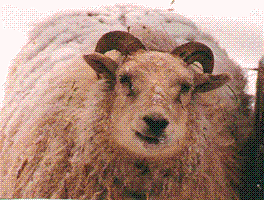
#403 Dokkvor ICELAND EWE LV 403 365252-H white horned ewe. She came from Kirkjubaejarklaustur farm. She was big and had very good conformation and medium wool. She was shy but not wild. She lived only 3 years and had 4 lambs. She died of pneumonia and a bad udder. She had 4 registered progeny.
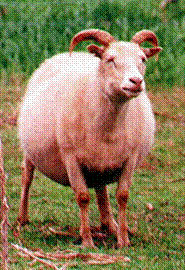
# 423 Fluta ICELAND EWE 423 365254 white horned. She came from Kirkjubaejarklaustur farm. She was big with good conformation. Her wool had extremely coarse tog. She had 4 sets of twins and was open one year. Her temperament was not particularly nice. She stamped her feet a lot and hissed at people. He name Flauta means whistle which her hiss sometimes sounded like. She was not aggressive; just stood her ground. She died from a bad udder. She had 5 registered progeny.
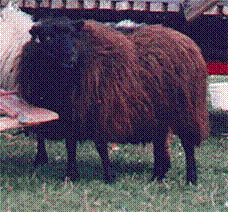
# 453 Segla ICELAND EWE 453 365249 Black polled ewe. She came from Seglbudir farm. She was small and loveable. She had a lamb in Iceland but lost it. Even though she was small, her conformation was excellent. She is STS7A Saddleback’s grandma and had the same build as Saddleback. She had 11 lambs in 5 years plus the one in Iceland. Her fleece was soft but not very long. She had 9 registered progeny. One of her most famous daughters is STS37Z Golsa.
RAMS:
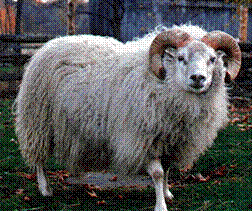
Larus #723 ICELAND RAM LV 723 365256-H White horned ram. He was named for the Farmer that bred him. He came from Kirkjubaejarklaustur farm. He was a big ram with good conformation and a medium fine fleece. He was friendly, calm and a good breeder. His horns had been cut in Iceland even though it would not have been necessary. He had 17 registered progeny.
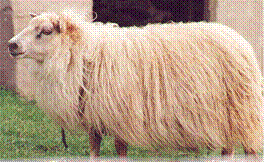
Tritill #830 ICELAND RAM 830 365250-P White polled ram. His name means “Shorty” to reflect his short broad conformation. He came from Hunkubakkar farm. He was wild, had a bad temperament and was impossible to catch. But he had a wonderful conformation; blocky and short legged like a pig, and a lovely fleece. He had 10 registered progeny.
|
Home | Breeding Stock | Products | Contact Us |
|
|
All
photos, graphics, and text: © Copyright Tongue River Farm, 2002 |